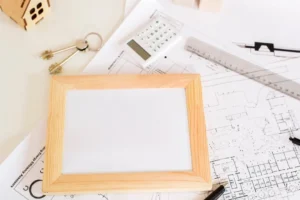Construction is only possible with proper planning and accurate estimates. Carefully estimating materials plays a crucial role in constructing reliable buildings. Estimates are usually calculated before starting a construction project so that material always remains in stock.
Early estimation also helps you calculate the project’s price and quote in a way that makes decent profits. Before going into the details of how to estimate materials for a house, let’s look at a few things (as listed below) that should be in our estimates.
- Note down all building materials.
- Note the price of each item the project needs.
- Sum up the price of each item.
- Calculate the labor cost throughout the project.
- Add 10% to 15% extra for waste.
Material Estimating Basics You Must Be Familiar With

How to estimate building materials? Though the material estimation may vary from building to building, some things remain the same, as given below.
- The price of each product per unit.
- The coverage or size of the product unit (packs that cover 15 square feet, 4 x 8 inches sheets).
- How a product is sold (in sheets, by the piece, by cubic yard, or in bundles).
Once familiar with these factors, you will become a better construction material estimator or building materials estimator for residential and commercial buildings.
How to Calculate Concrete Estimates

The “cubic yard” unit delivers pre-mixed concrete to your place. The equation below shows how to calculate the number of cubic yards.
(length x width x height) / 27 = cubic yards
For instance, if you want to prepare a 36’x24’x2’ concrete pad, the estimation would be like:
36’ x 24’ x 2’ = 1728
1728 / 27 = 64 cubic yards
Now, you must add at least 10% extra for waste materials. It will become.
64 + 64 x 10% = 70.4 cubic yards
How to Calculate Lumber Estimate

It is one of the key factors in estimating building materials. Usually, lumber is sold by the piece. Many lumberyards sell random-sized pieces and hardwood lumber by the board foot. Let’s calculate the board feet for lumber.
(length in feet x thickness in inches x width in inches) / 12 = board feet
For example, if you want to buy a piece of lumber with 10’ x 6” x 12” dimensions, let’s calculate the board feet.
10 x 6 x 12 = 720
720 / 12 = 60 board feet
Once you have this number, multiply it with the current price per board foot. It will help you estimate prices.
How to Calculate Estimates for Framing

This is another important phase of the material calculation for building construction. Follow the steps below to find how many 2x6s and 2x4s you need for a framed wall.
- First of all, calculate the total length of all the walls in feet.
- Suppose the center spacing is 16 inches. In that case, multiply 0.75 by the total length of the walls.
- Then, add extra studs for wall opening, wall inspection, and each corner.
- Multiply 3 by the total length and divide the number by the length of the boards. Doing this will help you calculate the sill and top plates.
- To add extra for waste, multiply 1.10 with the final answer.
How to Calculate Estimates for Wall Sheathing

To calculate the estimate for wall sheathing, you should first calculate the area to be covered. Once you have the area, divide it by 32 (if the sheet is 4’ x 8’) and by 48 (if the sheet is 4’ x 12’). Suppose the total area you want to cover is 1200 square feet. In that case, the equations for sheets with different sizes are given below.
1200 / 32 = 37.5 sheets of 4’ x 8’
or
1200 / 48 = 25 sheets of 4’ x 12’
Let’s now calculate the 10% extra amount for waste and anonyms cost while wall sheathing.
37.5 + (37.5 x 10%) = 41.25
or
25 + (25 x 10%) = 27.5
Once you get the answer, multiply it with the price per sheet. This is how you can calculate the estimate for the wall sheathing.
How to Calculate Estimate for Roofing

One more key parameter in the estimation of building materials is calculating the estimate for roofing. Usually, roof sizes are calculated in squares. Do you want to determine the number of squares on your roof? If yes, calculate the total square footage and divide it by 100. For instance, if your roof is 1000 square feet. Let’s determine its squares.
1000 / 100 = 10 squares
If your roof is shingled, 3 shingle bundles will be required to cover one square. Similarly, one roll of tar paper can cover 4 squares.
10 x 3 = 30 bubbles of shingles
10 / 4 = 2.5 rolls of tar paper
Final Words
How to estimate building materials for home construction? You need only list all the required materials, find the labor cost for the duration of the whole project, add up the material and labor costs, and add 10% of the total amount as extras or anonymous expenses.
If you are looking for professional assistance regarding building materials cost estimates or anything similar, contact Space Construction Inc. With years of experience in the construction industry, they will help you create your dream home.
FAQs
How do I calculate the amount of concrete needed for a project?
To calculate the amount of concrete needed, multiply the length, width, and height of the area in feet, then divide by 27 to get the total cubic yards. Add 10% extra to account for waste.
What factors should I consider when estimating lumber for construction?
Consider the length, thickness, and width of the lumber. Calculate the board feet using the formula (length in feet × thickness in inches × width in inches) / 12. Multiply the result by the price per board foot for cost estimation.
How do I estimate materials for framing a wall?
Calculate the total wall length, multiply by 0.75 for stud spacing at 16 inches, and add extra studs for openings and corners. Multiply by 3 for sill and top plates, and add 10% for waste.
How is wall sheathing estimated?
First, calculate the total area to be covered, then divide by 32 for 4’x8’ sheets or 48 for 4’x12’ sheets. Add 10% extra for waste and multiply by the price per sheet for the final estimate.
How do I calculate the roofing materials needed?
Calculate the total square footage of the roof and divide by 100 to find the number of squares. For shingled roofs, multiply the squares by 3 for shingles and divide by 4 for tar paper rolls.


0 Comments